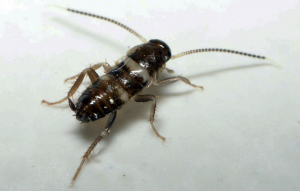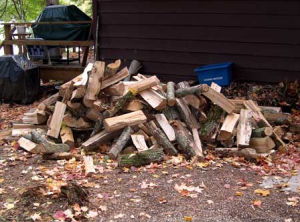The smokybrown roach gets its name from its uniform brown to mahogany color. This roach is also called a woods roach or water bug and very often confused with its cousin the American roach because of their similar size. Smokybrown roaches are very good fliers and although not considered quite the pest as some other roaches, populations still build up significantly where conditions are right. Moving inside an unsealed building is not a problem for this agile insect.
The life cycle of this roach is about 320 days from egg to adult and the incubation of the eggs inside the ootheca averages 45 days. Approximately 20 nymphs emerge from the eggs and begin life anew. The smokybrown cockroach requires constant moisture because it tends to dehydrate quickly. Outside you will most often find this roach associated with leaf litter, in a tree hole or under objects that tend to retain the precious moisture it needs. This roach is a scavenger and will feed on a wide variety of foods including decaying organic matter.
How They Travel
This roach is a very good flier and is attracted to lights at night. When their environment or surrounding begins to dry up, you’ll find this roach on the move and this is often into buildings. This roach prefers an area of little to no air flow and can often be found in large numbers in piles of leaf litter, debris or mulch. While more a pest of the Gulf states the smokybrown cockroach is also a major pest along the Mississippi and in many places where moisture is abundant. Since this roach is often found in mulch and shrubs it is possible that it can be transported via shipments.
How Best To Identify The Smokybrown Roach
Adults are about 1 1/4 inch in length, shiny and uniform in color, usually dark brown. Both the female and males wings completely cover the tip of their abdomen. The females abdomen is wider and lacks styli. Young nymphs or ‘baby’ roaches often have a white band across their thorax and on segments of their antenna. As they grow older they lose these markings altogether and this is a good way to rule out other roaches while trying to identify this roach since so many other roaches do have bands and marks.
wings completely cover the tip of their abdomen. The females abdomen is wider and lacks styli. Young nymphs or ‘baby’ roaches often have a white band across their thorax and on segments of their antenna. As they grow older they lose these markings altogether and this is a good way to rule out other roaches while trying to identify this roach since so many other roaches do have bands and marks.
Treatment And Elimination
Much like the asian roach, treatment begins outside. Start by removing as much leaf litter and debris as possible in your yard and close proximity. Old sheds, wood piles etc. with abundant wood rot and moisture problems need to be addressed to eliminate this harborage point. Thick shrubbery next to the home should be cut back so that air can flow and excess mulch should be removed if to thick or at the least raked and turned over to allow drying. Sealing up the homes cracks and gaps, cleaning gutters of debris will help as well as checking for light that could attract this roach at night. Gaps around doors and windows should be sealed to keep this and other pests out.
Treatment for the smokybrown is not always necessary once moisture and harborage conditions have been addressed however; this roach is very persistent and capable and may invade nearby structures or areas (other yards) in search of what it needs. A thorough exterior pest control treatment using insecticide liquids around doors, windows and eaves will work nicely along with a perimeter soil treatment with granules and baits. Dusting voids is  a very good option and ‘Delta’ dust works especially good in moisture situations and may be your best bet. Areas such as under decks or other voids are perfect place to find this roach. (look for the moisture and areas of little air flow)
a very good option and ‘Delta’ dust works especially good in moisture situations and may be your best bet. Areas such as under decks or other voids are perfect place to find this roach. (look for the moisture and areas of little air flow)
Inside you should concentrate on any area of high humidity or moisture. Liquids, baits or dusts also work well in these spots. Air flow is also key and if a room or area is stagnant and moist, consider a dehumidifier, a fan and de-cluttering the room if need be. It could be that your simple addition of air flow to the area will dry the brown roaches out in just a few short days and no real treatment may be necessary.




